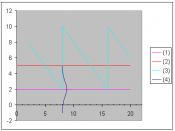Company Overview
Barilla SpA is a large, vertically integrated, family owned pasta company based in Italy. It maintains a leadership position among a field of thousands of Italian competitors producing and distributing brand-name pasta. Its operations are divided among 3 production divisions and two distribution channels, based on product shelf life. Distribution was further divided between two central distribution centers (CDCs), based on geography.
Customers were divided into three primary segments: Small retail shops; Large independent supermarkets; and Large supermarket chains. Distribution to small retail shops was direct from the CDCs. Distribution to the supermarkets went through intermediate distribution centers, either owned by the chain, or operated by a third party representing multiple independent supermarkets. Fresh product was distributed through a network of brokers.
Inventory levels in the supply chain, managed via periodic-review inventory systems, were high, with larger levels of safety stock held for dry pasta (which had longer shelf-lives) than for fresh pasta.
The CDCs carried approximately a 1-month supply in inventory, and supermarket distributors maintained a 2-week supply, yet stockouts still occurred frequently. These high inventory levels were in part a result of heat control issues in the production process making it difficult to respond quickly to shortages, so increased safety stock was the preferred response to demand variability.
Distribution Problems
The pasta supply chain suffered from classic bullwhip-effect problems: high inventory levels stored at each level of the supply chain; stockouts at the distributor level; demand variability magnification up the chain, and exacerbated by frequent promotions, Full Truck Load (FTL) and other volume incentives; and a lack of information on which to forecast demand.
Increasing product variability exacerbated all of these problems. Barilla maintained over 800 SKUs of dry pasta alone.
To combat these problems, the Director of Logistics desired to implement a Just In Time...


